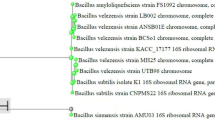Abstract
Capsaicin is a major representative component in pepper and it has gained interest by its health beneficial effects. An enzymatic hydrolysate of capsaicin has also been of great interest, because it can be applied to the reduction pungency of pepper or production of natural flavor. We first developed a simple screening method to isolate capsaicin-degrading bacteria showing a clear zone. A cloudy solid medium was prepared by the addition of capsaicin as sole carbon and nitrogen sources to 3-(Nmorpholino) propanesulfonic acid (MOPS) minimal medium, and the bacteria showing clear zone around the colony was isolated from Korean traditional pickled pepper. The isolated strain was identified as Bacillus licheniformis using 16S rRNA gene sequence analysis. B. licheniformis SK1230 was able to utilize capsaicin for both of carbon and nitrogen sources for its growth. The hydrolysis of capsaicin by B. licheniformis was verified using high-performance liquid chromatography, and capsaicin in medium was depleted depending on culture time. Capsaicin hydrolysate was composed of vanillylamine and capsiate (8-methyl-6-trans-nonenoic acid).
Similar content being viewed by others
References
Brans A, Filée P, Chevigné A, Claessens A, and Joris B (2004) New integrative method To generate Bacillus subtilis recombinant strains free of selection markers. Appl Environ Microbiol 70, 7241–7250.
Castillo E, López-González I, De Regil-Hernández R, Reyes-Duarte D, Sánchez-Herrera D, López-Munguía A et al. (2007) Enzymatic synthesis of capsaicin analogs and their effect on the T-type Ca2+ channels. Biochem Biophys Res Commun 356, 424–430.
Choi YJ and Ko YS (1990) Studues on the lipid components of red pepper seed oil. J Korean Home Econ Assoc 28, 31–36.
De Petrocellis L, Guida F, Moriello AS, De Chiaro M, Piscitelli F, de Novellis V et al. (2011) N-palmitoyl-vanillamide (palvanil) is a non-pungent analogue of capsaicin with stronger desensitizing capability against the TRPV1 receptor and anti-hyperalgesic activity. Pharmacol Res 63, 294–299.
Ferreira JS, Straathof AJJ, Franco TT, and van der Wielen LAM (2004) Activity and stability of immobilized penicillin amidase at low pH values. J Mol Catal B: Enzym 27, 29–35.
Flagan SF and Leadbetter JR (2006) Utilization of capsaicin and vanillylamine as growth substrates by Capsicum (hot pepper)-associated bacteria. Environ Microbiol 8, 560–565.
He L, Chen W, and Liu Y (2006) Production and partial characterization of bacteriocin-like pepitdes by Bacillus licheniformis ZJU12. Microbiol Res 161, 321–326.
Inoue N, Matsunaga Y, Satoh H, and Takahashi M (2007) Enhanced energy expenditure and fat oxidation in humans with high BMI scores by the ingestion of novel and non-pungent capsaicin analogues (Capsinoids). Biosci Biotechnol Biochem 71, 380–389.
Kumar A, Prabhune A, Suresh CG, and Pundle A (2008) Characterization of smallest active monomeric penicillin V acylase from new source: A yeast, Rhodotorula aurantiaca (NCIM 3425). Process Biochem 43, 961–967.
Lee S-M, Lee H-S, Lee J, Yu K-W, Kim K-M, Ra KS et al. (2010) Nonpungent Capsicum fermentation by Bacillus subtilis P3-3 and its swimming endurance capacity in mice. Enzyme Microb Technol 47, 200–205.
Neidhardt FC, Bloch PL, and Smith DF (1974) Culture medium for enterobacteria. J Bacteriol 119, 736–747.
Priest FG (1977) Extracellular enzyme synthesis in the genus Bacillus. Bacteriol Rev 41, 711–753.
Reilly CA, Crouch DJ, Yost GS, and Fatah AA (2002) Determination of capsaicin, noviamide and dihydrocapsaicin in blood and tissue by liquid chromatography-tandem mass spectrophotometer. J Anal Toxicol 26, 313–319.
Romano D, Gandolfi R, Guglielmetti S, and Molinari F (2011) Enzymatic hydrolysis of capsaicins for the production of vanillylamine using ECB deacylase from Actinoplanes utahensis. Food Chem 124, 1096–1098.
Tamura K, Dudley J, Nei M, and Kumar S (2007) MEGA4: Molecular Evolutionary Genetics Analysis (MEGA) software version 4.0. Mol Biol Evol 24, 1596–1599.
Tamura K, Nei M, and Kumar S (2004) Prospects for inferring very large phylogenies by using the neighbor-joining method. Proc Natl Acad Sci U.S.A. 101, 11030–11035.
Thompson JD, Higgins DG, and Gibson TJ (1994) CLUSTAL W: improving the sensitivity of progressive multiple sequence alignment through sequence weighting, position-specific gap penalties and weight matrix choice. Nucleic Acids Res 22, 4673–4680.
Torres S, Baigorí MD, Swathy SL, Pandey A, and Castro GR (2009) Enzymatic synthesis of banana flavour (isoamyl acetate) by Bacillus licheniformis S-86 esterase. Food Res Int 42, 454–460.
Van den Heuvel RHH, Fraaije MW, Laane C, and van Berkel WJH (2001) Enzymatic synthesis of vanillin. J Agric Food Chem 49, 2954–2958.
Wang B, Yang F, Shan Y-F, Qiu W-W, and Tang J (2009) Highly efficient synthesis of capsaicin analogues by condensation of vanillylamine and acyl chlorides in a biphase H2O/CHCl3 system. Tetrahedron 65, 5409–54012.
Weisburg WG, Barns SM, Pelletier DA, and Lane DJ (1991) 16S ribosomal DNA amplification for phylogenetic study. J Bacteriol 173, 697–703.
Yildiz Zeyrek F and Oguz E (2005) In vitro activity of capsaicin against Helicobacter phylori. Ann Microbiol 55, 125–127.
Zhang D, Koreishi M, Imanaka H, Imamura K, and Nakanishi K (2007) Cloning and characterization of penicillin V acylase from Streptomyces mobaraensis. J Biotechnol 128, 788–800.
Author information
Authors and Affiliations
Corresponding author
Rights and permissions
About this article
Cite this article
Cho, S., Moon, HI., Hong, GE. et al. Biodegradation of capsaicin by Bacillus licheniformis SK1230. J Korean Soc Appl Biol Chem 57, 335–339 (2014). https://doi.org/10.1007/s13765-013-4277-0
Received:
Accepted:
Published:
Issue Date:
DOI: https://doi.org/10.1007/s13765-013-4277-0




